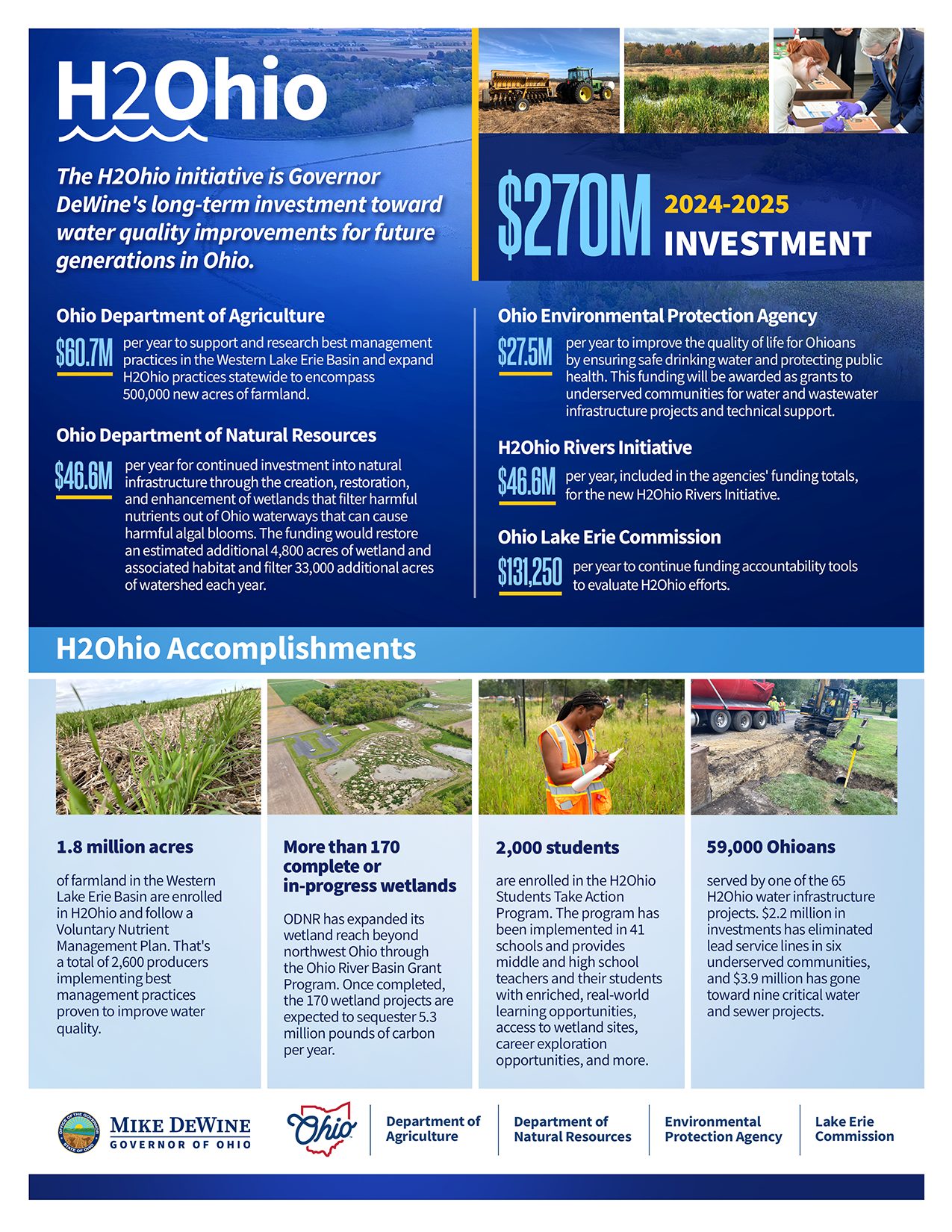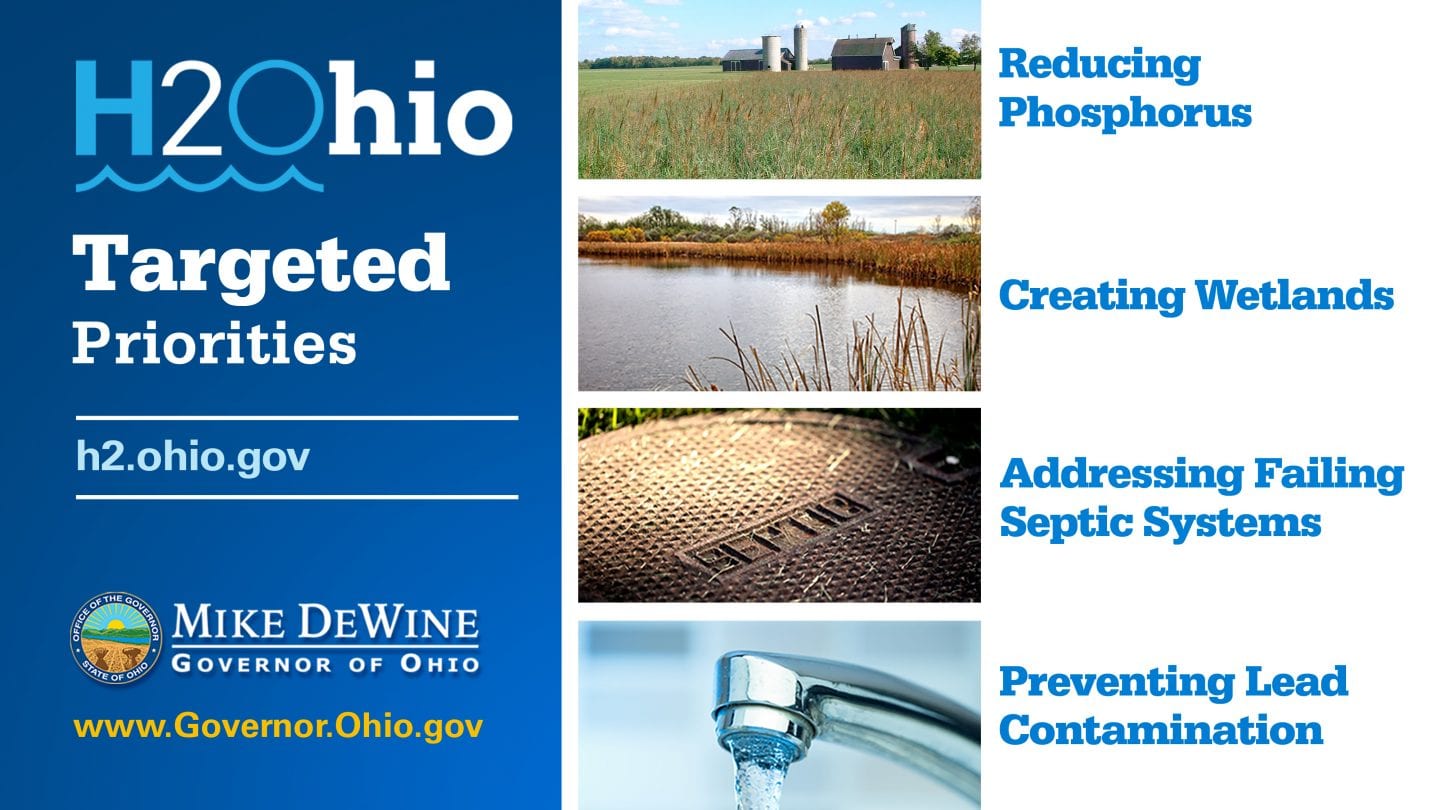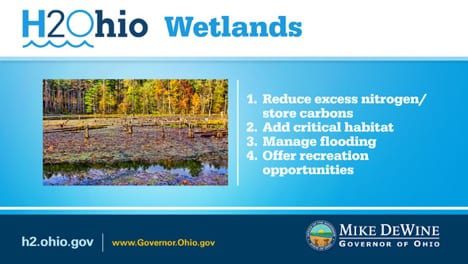About H2Ohio
Launched by Governor Mike DeWine in 2019, H2Ohio is a comprehensive water quality initiative that is working to strategically address serious water issues that have been building in Ohio for decades. Such problems include harmful algal blooms on Lake Erie caused by phosphorus runoff from farm fertilizer, failing drinking water, wastewater, and home sewage treatment systems due to aging infrastructure, and lead contamination from old water pipes and fixtures.

Ohio’s water quality issues took time to develop, and it will take time to reverse course. Continued investment by the General Assembly will allow H2Ohio to continue building on its progress.
H2Ohio was created through unprecedented collaboration, using strategies that are long-term, sustainable, science-based and cost-effective. The Governor, the Ohio Department of Agriculture, the Ohio Department of Natural Resources, the Ohio Environmental Protection Agency, the Lake Erie Commission, and many partners, including the Ohio Agriculture Conservation Initiative (OACI) have worked together to invest in projects across Ohio that will reduce nutrients and provide other long-term economic and water quality benefits to communities statewide.


Reducing Agricultural Phosphorus Runoff to Prevent Algal Blooms
The H2Ohio plan will invest substantially to help farmers reduce phosphorus runoff from commercial fertilizer and manure to prevent harmful algal blooms.
Algal blooms in Ohio’s lakes, rivers, and streams can threaten drinking water and impact the health of people and animals. Although studies have shown that phosphorus runoff from farms is the primary reason for algal blooms in Lake Erie, Ohio has not previously placed a significant focus on addressing this problem.
“Ohio has supported many programs to help farmers reduce nutrient loss over the years, but the state hasn’t done nearly enough, nor have previous plans focused enough, on reducing phosphorus runoff from agriculture,” said Governor DeWine. “That changes now.”
As a result of intensive scientific and economic studies, H2Ohio identified seven effective and cost-efficient practices that have been proven to reduce agricultural phosphorus runoff. H2Ohio will provide economic incentives to farmers who implement best management practices, starting with a voluntary nutrient management plan.
The H2Ohio phosphorus reduction plan will focus first on reducing runoff into the Maumee River Watershed and Lake Erie and will eventually be offered to other parts of the state in the future. Farmers in the Maumee River Watershed will be able to enroll in H2Ohio programs for funding incentives in time for spring 2020 planting.
“For now, we will not mandate the use of these best practices because we believe our strategy will lead to significant changes within our current laws,” said Governor DeWine. “By helping farmers implement these practices today, H2Ohio will ultimately save them money, increase their profits, and reduce their phosphorus runoff in the future. Although a decrease in Lake Erie algal blooms will take time, we must invest now if we want clean water for future generations.”
 As part of the H2Ohio plan, counties in the Maumee River Watershed will each have a localized phosphorus target to help ensure accountability. Individualized nutrient management plans will also be developed for participating farms to identify which H2Ohio best practices will reduce the most phosphorus runoff at each location. Soil and Water Conservation District Offices in each county will lead local efforts to help farmers enroll in the H2Ohio program and to help them implement the H2Ohio best practices. The overall progress of the H2Ohio phosphorus reduction plan will be regularly assessed and aggregate data will be publicly available. The plan was developed with input from a broad coalition of agriculture, education, research, conservation, and environmental partners. H2Ohio will be led by the Ohio Department of Agriculture, Ohio Department of Natural Resources, Ohio Environmental Protection Agency, and Lake Erie Commission with support from the Ohio Agricultural Conservation Initiative, Ohio Farm Bureau, U.S. Department of Agriculture, and others. Several of the country’s largest agribusiness operations, including Land O’Lakes, Nutrien, and The Andersons, have voiced support for the plan and have agreed to promote H2Ohio to their customers to help increase the number of acres enrolled in best practices.
As part of the H2Ohio plan, counties in the Maumee River Watershed will each have a localized phosphorus target to help ensure accountability. Individualized nutrient management plans will also be developed for participating farms to identify which H2Ohio best practices will reduce the most phosphorus runoff at each location. Soil and Water Conservation District Offices in each county will lead local efforts to help farmers enroll in the H2Ohio program and to help them implement the H2Ohio best practices. The overall progress of the H2Ohio phosphorus reduction plan will be regularly assessed and aggregate data will be publicly available. The plan was developed with input from a broad coalition of agriculture, education, research, conservation, and environmental partners. H2Ohio will be led by the Ohio Department of Agriculture, Ohio Department of Natural Resources, Ohio Environmental Protection Agency, and Lake Erie Commission with support from the Ohio Agricultural Conservation Initiative, Ohio Farm Bureau, U.S. Department of Agriculture, and others. Several of the country’s largest agribusiness operations, including Land O’Lakes, Nutrien, and The Andersons, have voiced support for the plan and have agreed to promote H2Ohio to their customers to help increase the number of acres enrolled in best practices.
Creating Wetlands
 In addition to reducing phosphorus runoff, wetlands also offer additional environmental benefits by absorbing pollutants, slowing down the movement of water, offering a natural filtering process, and preventing the further movement of contaminated matter. The H2Ohio program will create, restore, and enhance wetlands in strategic, targeted areas. Our efforts are statewide with an initial emphasis on the Western Lake Erie Basin, specifically within the Maumee River Watershed. These wetland practices will reduce phosphorus runoff and nitrogen, store carbons, manage flooding, and offer recreation opportunities. H2Ohio wetlands will be monitored and managed but will be primarily self-sustaining once established.
In addition to reducing phosphorus runoff, wetlands also offer additional environmental benefits by absorbing pollutants, slowing down the movement of water, offering a natural filtering process, and preventing the further movement of contaminated matter. The H2Ohio program will create, restore, and enhance wetlands in strategic, targeted areas. Our efforts are statewide with an initial emphasis on the Western Lake Erie Basin, specifically within the Maumee River Watershed. These wetland practices will reduce phosphorus runoff and nitrogen, store carbons, manage flooding, and offer recreation opportunities. H2Ohio wetlands will be monitored and managed but will be primarily self-sustaining once established.
Ensuring Safe, Clean Water
 H2Ohio will address water and sewer needs in Ohio, including failing home septic systems in disadvantaged communities and possible lead contamination in high-risk daycare centers and schools. “Ohio’s communities rely on clean drinking water and wastewater infrastructure to protect public health, provide for a high quality of life, and enable economic vitality,” said Governor DeWine. “It is wrong that Ohio children are potentially being exposed to lead in drinking water because of antiquated piping and fixtures in daycare centers or they can’t play outside because their backyards are covered in sewage from failing septic systems. H2Ohio is going to help.” Under the direction of the Ohio Environmental Protection Agency, H2Ohio will fund infrastructure projects in disadvantaged communities to help ensure they have safe drinking water and quality sewer infrastructure. H2Ohio will also help replace hundreds of failing home sewage treatment systems in low-income households to prevent the release of raw sewage onto property or into waterways.
H2Ohio will address water and sewer needs in Ohio, including failing home septic systems in disadvantaged communities and possible lead contamination in high-risk daycare centers and schools. “Ohio’s communities rely on clean drinking water and wastewater infrastructure to protect public health, provide for a high quality of life, and enable economic vitality,” said Governor DeWine. “It is wrong that Ohio children are potentially being exposed to lead in drinking water because of antiquated piping and fixtures in daycare centers or they can’t play outside because their backyards are covered in sewage from failing septic systems. H2Ohio is going to help.” Under the direction of the Ohio Environmental Protection Agency, H2Ohio will fund infrastructure projects in disadvantaged communities to help ensure they have safe drinking water and quality sewer infrastructure. H2Ohio will also help replace hundreds of failing home sewage treatment systems in low-income households to prevent the release of raw sewage onto property or into waterways.
Additionally, through a combination of state and federal funds, H2Ohio will assess lead exposure in daycare centers and schools in high-risk areas of Ohio and will help replace lead pipes and fixtures.
